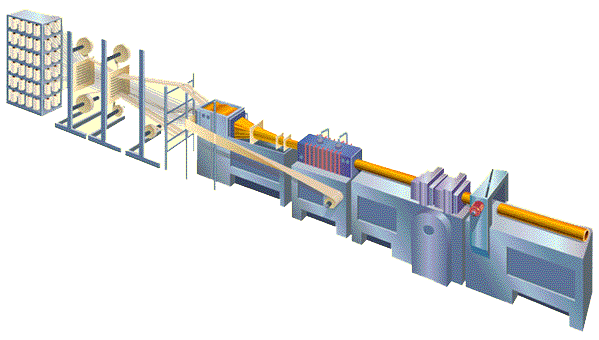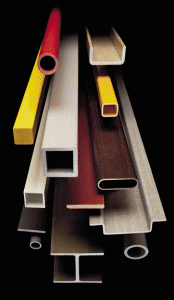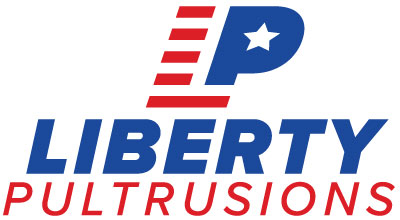- Home
- The Pultrusion Process

How Pultrusions Are Manufactured
The pultrusion process is a very efficient way to manufacture fiber reinforced composite products. It allows pultrusion manufacturers to produce continuous lengths of fiber-reinforced polymer (FRP) profiled shapes.
This “pulling” process permits the strategic placement of continuous strand glass fiber, fiberglass mats and C/W Barrier, allowing for optimization of structural properties. FRP Pultruded structural shapes have a superior long-term resistance to chemical corrosion and other weathering. Pultruded shapes will not rust, rot, scale or mildew.
The term “pultrusion” is actually a combination of the words “pull” and “extrusion”. This makes sense when we realize that the pultrusion process involves a machine pulling the fiberglass through a liquid resin and then pulling that combination of glass and resin through a heated die. Extrusion is the process of creating objects of a fixed cross-sectional profile through a pushing process.
Fiber Reinforced Polymers or Plastic is a versatile material that can be tailored to customers’ specifications through the pultrusion process. Because FRP composites are a mixture of resin, fiber reinforcement and additives, the amount and “ingredient” can be adjusted to make an optimal product for your specific project.
The Pultrusion Process:
First, the pultrusion process involves pulling or drawing fiberglass (in the form of continuous roving filaments, or fiber bundles) though a liquid resin which saturates the glass reinforcement. This saturation with the resin mixture (called “wet-out”) allows for multidirectional reinforcement, which is why pultrusion results in a strong material. Resin types can include polyester, vinyl ester, polyurethane and epoxy. Here a surface veil may also be added to protect against erosion or “fiber bloom” and provide corrosion resistance and ultraviolent resistance.
Second, the combination of resin and fiberglass is then pulled through a special heated and shaped die (in a process called polymerization) using a continuous pulling device.
Next, the mass of reinforcement material hardens to conform to the shape of the die and is heat-set into a permanent and rigid structurally reinforced shape.
Lastly, the resulting high-strength profile is then cut to length — ready for use when it leaves the pultrusion machine.
RANGE OF TECHNICAL CAPABILITIES
Liberty Pultrusions offers a wide range of manufacturing and technical capabilities to meet specific needs. Our FRP structural pultrusions are available in both polyester and vinyl ester resin formulations combined with engineered glass fiber architecture. These materials are configured to meet various functional requirements. FRP structural are adaptable to many building applications as supports for roof and wall panels, as structural components in corrosive environments and, because they are so light weight, are easily installed using conventional construction methods – no welding or heavy lifts needed.
The formula for creating pultrusion can involves combinations of the following:
- The resin matrix: Polyester, vinyl ester and a variety of urethane products
- The fiber reinforcement: fiberglass roving, mat, and other specialty glass reinforcements
- The amount of fiber reinforcement used
- Additives/Fillers – Fire resistant and fire retardant materials, UV blockers, pigments/colors, etc.
Pultruded products provide manufacturers and designers with the benefits of high strength-to-weight ratios, corrosion resistance, heat resistance, dielectric properties, dimensional stability and weatherability.
FRP Pultrusions are a cost effective and versatile alternative to traditional materials, such as steel, aluminum and timber. FRP Pultrusions weigh 75% less than steel, but are just as strong and won’t corrode or rust easily.
Key Advantages of Polyglas Electrical Pultrusion:
- Non conductive thermally and electrically
- Non-magnetic
- Electromagnetic transparency
- Lightweight
- High strength
- Dimensional stability
- Long life cycle
- Low maintenance
- UL listed
- Fire retardant
- Arc and track resistant
Key Advantages of FRP Structural Pultrusion:
- Corrosion resistance
- Chemical resistance
- Non-conductivity (thermally and electrically)
- Having non-magnetic electromagnetic transparency
- Being lightweight
- High-strength & durability
- Impact resistant
- Dimensional stability
- A long life cycle
- Low-maintenance

